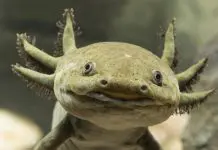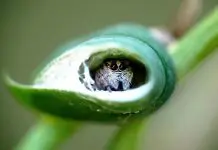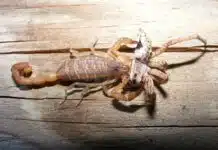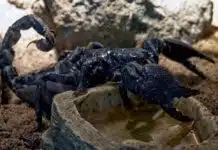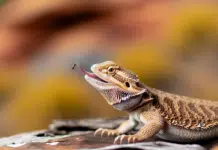Brief Overview of Hermit Crabs as Pets
Hermit crabs are fascinating creatures that make great pets for both children and adults. They are easy to care for, require little space, and have unique personalities that make them fun to watch.
One of the most interesting things about hermit crabs is their unique ability to change shells as they grow. When they outgrow their current shell, they will search for a new one and move in.
It is important to note that hermit crabs are social animals and should be kept in groups of two or more. They prefer a warm, humid environment that mimics their natural habitat on the beach.
Importance of Proper Tank Setup for Their Well-being
To ensure the health and well-being of your pet hermit crab, it is essential to provide them with a proper tank setup. A well-designed tank will offer your crab a comfortable home where it can thrive. The right tank setup includes proper temperature and humidity levels, adequate space, a substrate that mimics their natural environment, decorations for stimulation, lighting sources, and clean water sources.
Without these key elements in place, your pet hermit crab could become stressed or even sick. So if you want your hermit crab to live a long and healthy life under your care, don’t skip any steps when setting up their tank!
Tank Size and Type: Finding the Perfect Home for Your Hermit Crabs
As with any living creature, hermit crabs require a safe and comfortable living space to thrive. When it comes to tank size, a general rule of thumb is to have at least 5 gallons of space per crab. So, if you have two hermit crabs, you’ll want a minimum of 10 gallons of space.
Keep in mind that this is the minimum recommendation – more space is always better! When selecting a tank, there are several types available: glass, plastic, acrylic and mesh.
Glass tanks are the most popular choice as they are sturdy and maintain heat well. They also provide clear visibility for observing your crabs.
Plastic tanks are lightweight and easy to clean but may not hold up well over time. Acrylic tanks are similar to glass tanks but can scratch easily if not cared for properly.
Mesh tanks offer great ventilation but may not retain heat as well as glass or plastic. Each type of tank has its own pros and cons depending on your needs and budget.
Glass Tanks
Glass tanks provide good ventilation while retaining heat well which makes them perfect for keeping hermit crabs healthy in any environment! They come in many sizes from small desktops to large floor models giving you plenty of choices when trying to find one that fits your home or office décor.
Pros:
- Sturdy construction
- Retains heat well
- Clear visibility
Cons:
- Heavy (may be difficult to move once set up)
- Can break if dropped or hit
Plastic Tanks
Plastic tanks are lightweight, easy to clean, and affordable making them an excellent option for those on a tight budget.
Pros:
- Light weight
- Easy cleaning – Inexpensive
Cons:
- May warp or discolor over time
- Can scratch easily – Less heat retention vs glass
Acrylic Tanks
Like glass, acrylic is sturdy and provides clear visibility. However, it does have a tendency to scratch more easily than glass.
Pros:
- Strong and durable
- Clear visibility
- Good heat retention
Cons:
- Scratches easily
- May discolor over time – More expensive than plastic
Mesh Tanks
Mesh tanks provide excellent ventilation but may not retain heat as well as other types of tanks. They are great for providing a natural environment for hermit crabs because they allow for airflow and humidity control. Pros:
- Great ventilation
- Allows for the natural environment
Cons:
- Less heat retention than other tank types
- May not hold up as well over time Choosing the right tank size and type is crucial for the well-being of your hermit crabs.
Assess your needs before making a selection based on your budget, ease of use, durability, and aesthetics. A happy crab makes for a happy owner!
Substrate: The Foundation of Your Hermit Crab’s Home
Choosing the right substrate for your hermit crab is crucial for their health and well-being. The two most commonly used substrates are sand and coconut fiber, also known as Eco Earth.
Sand is great for burrowing but can be difficult to keep moist, while Eco Earth retains moisture better but may not provide enough traction for climbing. Some owners even use a mixture of both substrates.
It’s important to avoid using chemical-laden sand or soil from outdoor environments, as it can contain harmful pesticides and fertilizers that are toxic to hermit crabs. Instead, look for high-quality substrates at your local pet store or online retailer.
Once you’ve chosen your substrate, add enough to the tank so that it covers the bottom with a depth of at least 3 inches. This will give your hermit crab plenty of space to burrow and explore.
Decorating Your Hermit Crab’s Home: Adding Rocks, Shells, and Plants
Hermit crabs are scavengers in nature and will often use shells or other objects found in their environment as a home. In captivity, it’s important to provide them with a variety of options.
Adding natural-looking rocks can add texture and dimension to the tank while providing a place for your crab to climb on or hide behind. Make sure they are smooth without any sharp edges that could injure your pet.
Shells are also essential for hermit crabs since they need them to move into larger sizes as they grow. Provide a variety of shell sizes so that each crab has options when choosing their new home.
Adding plants such as moss or vines can create an aesthetically pleasing natural environment while also giving your crabs something fun to climb on or hide under. Just make sure any plants used in the tank have not been treated with herbicides or pesticides.
Creating a Natural Environment for Your Hermit Crab: Replicating their Wild Habitat
Hermit crabs are used to living in a particular environment in the wild, and it’s important to try and replicate this as much as possible. In the wild, they live near the shore, so adding a few seashells or small rocks to create a shore-like environment can help them feel comfortable.
To maintain their natural habitat, add saltwater and freshwater pools to the tank. This will give them an opportunity to swim and drink regularly.
You can purchase salt mixes specifically designed for hermit crab tanks at your local pet store or online retailer. Overall, try to create natural hiding places that allow your hermit crab’s instincts to shine through.
Provide plenty of places for them to hide under or climb on while also keeping safety in mind. By providing a natural habitat for your hermit crab, you’re setting them up for success and ensuring they have everything they need to live a happy life in captivity.
Temperature and Humidity Control
Optimal Temperature Range for Hermit Crabs
Maintaining the right temperature range in your hermit crab tank is crucial for their well-being. The ideal temperature range for hermit crabs is between 75-85°F, with a minimum of 70°F and a maximum of 90°F. Temperatures below or above this range can be harmful to your hermit crabs, as they cannot regulate their body temperature on their own.
The easiest way to maintain the correct temperature in your tank is by using an aquarium heater. Make sure to place the heater at one end of the tank to create a heat gradient, allowing your crabs to choose their preferred temperature zone.
Maintaining Proper Humidity Levels in the Tank
Hermit crabs are native to tropical regions and require high humidity levels in their tanks. The ideal humidity level for hermit crabs is between 70-80%.
Low humidity levels can cause respiratory problems and make it difficult for them to breathe. To maintain proper humidity levels in your tank, mist it regularly with dechlorinated water or use a spray bottle.
Adding a hygrometer is also essential as it helps monitor the humidity level inside your tank. You can find hygrometers at any pet store or online.
Using a Hygrometer to Monitor Humidity
A hygrometer measures the amount of moisture present in the air inside your crab’s tank so that you can maintain proper humidity levels. They come in analog or digital form and are easy to use.
To use a hygrometer, first, place it on one end of the tank away from direct light and water sources like pools. Wait about an hour before reading the measurement displayed on the device.
If you notice that humidity levels are too low or too high, adjust your misting routine or increase/decrease ventilation. Remember to keep a spray bottle handy to mist the tank as needed.
Maintaining proper temperature and humidity levels is crucial to the health and well-being of your hermit crabs. Investing in a good quality thermometer and hygrometer will help you make sure that you are providing the best possible environment for your pets.
Lighting and Feeding
Types of Lighting Needed for Hermit Crab Tanks
One of the most important aspects of a hermit crab’s habitat is lighting. Hermit crabs are nocturnal creatures, which means that they need a source of light to keep their circadian rhythm in check. However, they also need to be able to hide in the dark during the day.
To achieve this, a combination of ambient light and spotlights should be used. Full-spectrum lighting bulbs are recommended as they mimic natural sunlight and provide the right spectrum for your pet.
Feeding Schedule and Types of Food Recommended
Hermit crabs are omnivores which means they eat both plants and animals. In the wild, they feed on fruits, leaves, dead animals, or shells that contain algae.
To ensure your pet gets all the necessary nutrients it is important to provide a variety of foods. A recommended feeding schedule is every other day as overfeeding can cause obesity and other health issues.
A varied diet will make sure that all nutritional requirements are met and also prevent boredom with food choices. Foods that can be offered include fresh fruits such as apples or bananas that have been washed thoroughly before feeding them to your pets.
Vegetables such as cucumbers or lettuce are also options but should be given in moderation because overfeeding can lead to diarrhea or digestive problems. Commercial hermit crab food is another option that you could offer your pet if you want to ensure its nutritional needs are being met without having to worry about preparing different foods all the time.
Offering Fresh Water and Saltwater Pools
Providing fresh water dishes for drinking water is essential for your pet’s well-being. The dish should be shallow enough so that it cannot drown if it accidentally falls into it but deep enough so that it doesn’t dry out too quickly.
Saltwater pools should also be included in your hermit crab’s habitat. A saltwater pool provides a source of electrolytes that are necessary for your pet’s health.
The water should be changed regularly to avoid the buildup of bacteria and algae but do not change the whole pool at once as it can shock the crabs and cause them to become stressed. Providing the right lighting and feeding schedule is essential for keeping your pet’s habitat healthy.
It is important to remember to offer a varied diet, including natural foods, commercial food, freshwater dishes, and saltwater pools. Keep these tips in mind and you will have a happy, healthy hermit crab for years to come!
Health Concerns
Hermit crabs are just like any other living creature. They can get sick and stressed.
Therefore, it is important to keep an eye on your hermit crab’s behavior to ensure that they are healthy and happy. Here are some common health concerns that you should look out for.
Signs that indicate your crab may be sick or stressed
It can be difficult to tell if your hermit crab is feeling ill or stressed because they do not show signs of illness as obviously as other pets would. However, there are a few things that you should look out for. One of the most obvious signs is a lack of activity.
If your hermit crab is not moving around much or hiding in their shell all the time, it could be a sign that they are not feeling well. Another sign of sickness is a change in appearance.
If your hermit crab’s color has faded or if its exoskeleton looks dull and lifeless, this could also indicate an illness. If your hermit crab is losing limbs or if there are any wounds on its body, these could be signs of stress or illness.
Treatments for common health issues
If you notice any signs of illness or stress in your hermit crab, it is important to act quickly before the problem gets worse. Here are some common health issues and their treatments: If your hermit crab has lost limbs due to stress or fighting with other crabs, you can help them regenerate their limbs by providing them with plenty of calcium-rich foods like eggshells and cuttlebone.
If you notice signs of mites on your hermit crab’s exoskeleton like tiny dots moving around under their shell plates, then it’s time to visit a veterinarian who specializes in exotic animals since mites can cause serious infections in these tiny creatures Hermit crabs can also develop shell rot, a fungal infection that eats away at the inside of their shell.
Treatment for this involves cleaning the affected area with a solution of vinegar and water and providing them with a clean new shell. If you notice any signs of respiratory issues, such as difficulty breathing or coughing, it could be due to poor tank conditions or infection.
To treat these issues, make sure that the tank is clean and has proper ventilation. If symptoms persist, it is best to take your hermit crab to see a veterinarian.
Caring for your hermit crab’s health should be your top priority. By keeping an eye out for signs of illness and stress, you can help ensure that your hermit crab remains healthy and happy in their habitat.
Conclusion
Summary of key points to remember when setting up a hermit crab tank
Setting up a proper home for your hermit crabs requires attention to detail and careful consideration of their needs. Start by choosing the right tank size and type based on the number of crabs you have.
The ideal substrate is a mix of sand and coconut fiber, along with plenty of decorations like rocks, shells, and plants to create a natural environment. Temperature and humidity control is crucial for your crab’s well-being.
Keep the tank at a steady temperature between 75-85°F and use a hygrometer to monitor humidity levels, which should stay between 70-80%. Lighting is important too — use full spectrum bulbs that simulate natural sunlight.
Feeding your hermit crabs should be done on a regular schedule with fresh fruits, vegetables, protein, and calcium sources like cuttlebone or eggshells. Always provide them with both freshwater and saltwater pools.
It’s important to recognize potential health concerns in your hermit crabs such as lethargy or loss of appetite. Keep an eye on them regularly so you can catch any issues early on.
The joy that comes with providing a comfortable home for your pet her
Providing your hermit crabs with all they need to thrive in their new home can be both rewarding and exciting. Watching them explore their new environment will bring you joy as you see them interact with their surroundings in various ways. Maintaining their habitat will also give you an opportunity to connect with nature by creating an ecosystem within the tank.
There’s nothing quite like knowing that you’re giving these fascinating creatures the best life possible by offering them everything they need for optimal health and happiness. So go ahead – take pride in being an excellent caregiver for your pet hermit crab!

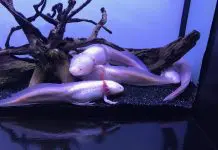

![Sick Axolotl, Fungus, Stress Symptoms [Axolotl Illness Guide 2025] Axolotl fungus](https://exopetguides.com/wp-content/uploads/2018/06/axolotl-218x150.jpg.webp)
